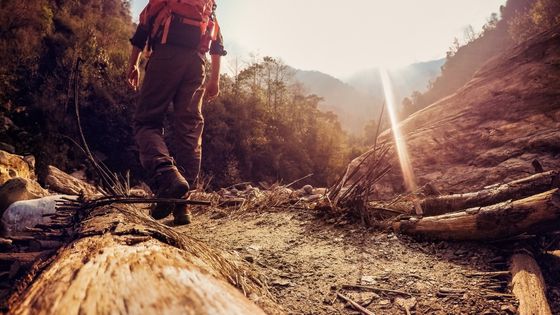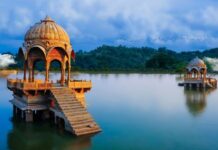An Overview
The most popular trek to the foot of Mount Kanchenjunga, the world’s third-highest peak, is the Goecha La Trek in Sikkim. The route is entirely within the boundaries of Kanchenjunga National Park. As a result, the forest on this route is denser and greener than on most others. There are numerous opportunities to observe various flora and fauna species. The region is home to the Himalayan Black Bear, Blue sheep, Thar, Snow Leopard, Foxes, and Red Panda, as well as several bird species, including a few that are critically endangered, such as the Blood Pheasant. Rhododendrons are plentiful in the area. There are also pink, white, red, and yellow rhododendrons in the area.


This trek’s highlight is the breath-taking mountain views from a majestic pinnacle. Similarly, the Dzongri peak provides views of not only Kanchenjunga but also 16 other Himalayan peaks. This breath-taking view of Kanchenjunga from here is also depicted on INR 100 banknotes.
About the Trek
The trek starts in Yuksom at 1,780 metres and gradually ascends to Tshoka at 2,743 metres through a dense tropical forest of pine, bamboo, fir, oaks, and flowering trees like magnolias and rhododendrons, which is home to several wildlife and bird species at various altitudes. The journey to Dzongri then continues with a steep ascent to the 3,650-meter-high Alp of Padang. There is an acclimatisation day at Dzongri, and one can climb to Dzongri Top for a panoramic view of Kabru (7,353 metres), Ratong (6,678 metres), Kanchenjunga (8,586 metres), Koktang (6,147 metres), Pandim (6,691 metres), and Narsing (5,825 metres).
To the west, the Singalila Ridge, which separates Sikkim from Nepal, can be seen. The trail continues to Goecha La on its way to Thangsing (3,800 metres) and Lake Samiti, which is surrounded by a lovely alpine meadow. The path to Goecha La continues uphill until you reach the glaciated tracks. The surrounding area is dotted with a number of small glacial lakes. Continue on the same path downhill.
The Dzongri
Goecha La trek requires an Inner Line Permit, an official travel document issued by the Government of India. The trek, which lasts 11-12 days, is best done in March, April, May, June, September, and October. During the winter, the tracks are usually bedded with a thick layer of snow, making the journey more difficult.
What Should You Expect?
The Sikkim Goechala Pass Trek from Dzongri offers breath-taking close-up views of the Kanchenjunga Range at sunrise and sunset. Looking down from Goechala Pass, you can see the terrain you came up on the left and Kanchenjunga’s snows forming a great glacial circle on the right.
The Goechala Trek Route
The trek begins in Yuksom, which serves as the basecamp from which you will embark on this journey on foot. Your next stop on the trail will be Sachen. On your way to Sachen, you will cross many bridges and may see animals such as mules and yak. Similarly, your next destination will be Tshoka and Bakhim, with some difficult climbing as well as dense forests full of rhododendrons and alpine berries that will brighten the path and make your trek more vibrant. The next stop is Dzongri, which is a significant milestone in this journey; some people only return after a day or two of rest. You can also learn about the culture by visiting a nearby village. Later, you’ll pass through Lamuney, Samiti Lake, and finally Goecha La, your destination.
Why is the Goechala Trek regarded as the best trek in India?
- The breath-taking views of the mountain range are one of the main reasons to go on the Goechala trek. The Goechala trek is compared to any difficult trek in Nepal.
- Trekkers visit Goechala to witness the sunrise over the Kanchenjunga Range.
- The Samiti Lake is one of the most important attractions on the Goechala trek. The breath-taking views of the lake’s still water and, especially, Mt Pandim’s reflection in the lake is literally breath-taking.
What You Should Do On A Goechala Trek
A trek to Goechala will bring you almost face to face with Mt. Kanchenjunga. Goechala is considered the base camp for the Kanchenjunga Trek. Glaciers, rocky terrain, flora and fauna, and the breath-taking Samiti Lake all welcome you to an unforgettable experience.
1. Engage with the Yuksomians
Yuksom, West Sikkim’s lush green and unspoiled village, is a must-see on the Goechala Trek. Aside from the natural beauty, the welcoming attitude and generosity of the locals, who always greet passers-by with smiles, will astound you.
2. Bakhim’s Natural Beauty Will Take Your Breath Away
Bakhim is a paradise for trekkers, surrounded by dense forests of magnolia, rhododendron, orchids, and ferns. The stunning views of the valleys, hills and Prekchu River are the cherry on top!
3. The breath-taking views from Dzongri’s summit will fill your soul.
The best part of the Goechala trek is the Dzongri Summit, which offers breathtaking 360-degree views of the mountains and their snow-capped peaks. The summit is located on top of a hill in the picturesque Himalayan Range at an elevation of 4,250 metres.
4. Consider Tshoka’s Morning Glory.
Tsokha is a tiny refugee settlement in Kanchenjunga National Park that serves as an ideal overnight stop for trekkers. It is located at an elevation of 3,400 metres. It is well-known for providing visitors with the most spectacular sunrise views over Mt. Pandim.
5. Spend the night under the stars in Thangsing.
Thangsing is a charming overnight stop for trekkers, with its sprawling meadows and quaint little river. Thangsing, in addition to being a scenic stop, is also a haven for night photographers, who can camp here and capture breath-taking views of the Milky Way Galaxy overhead.






















